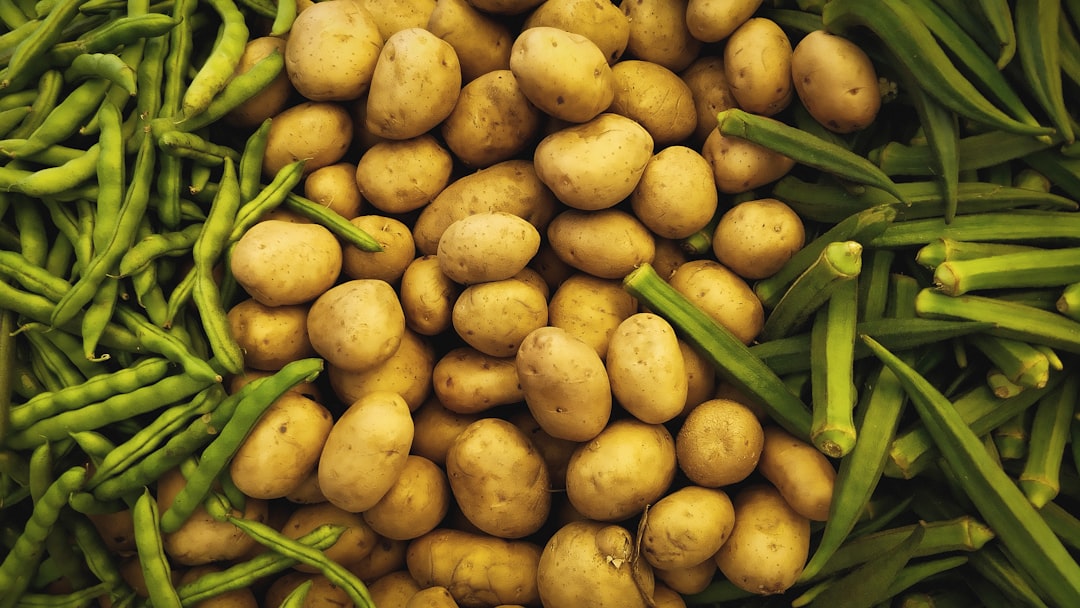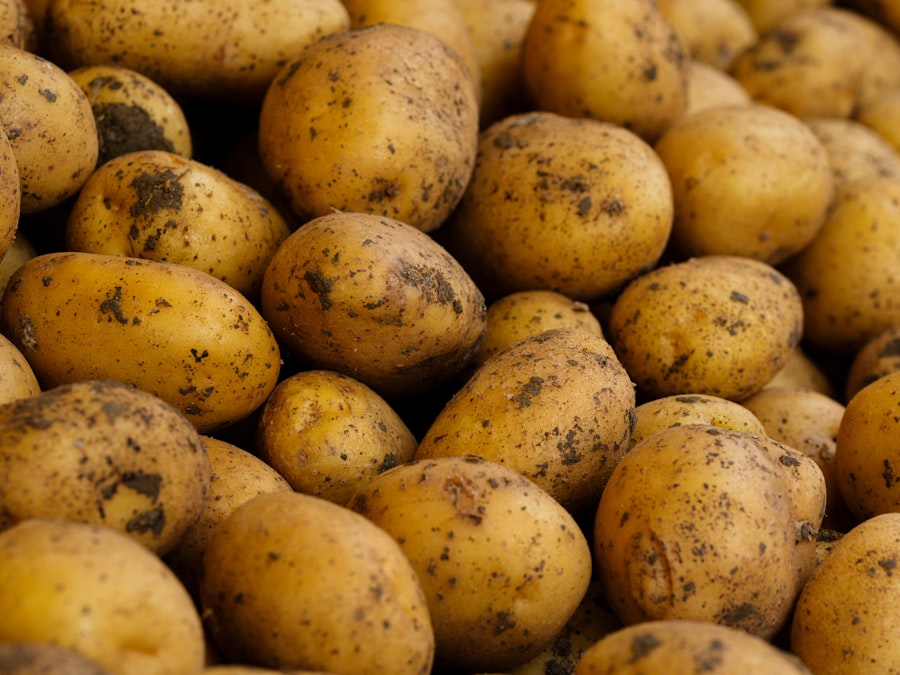Potato Harvest: When to Dig Up Your Spuds

Potatoes are a staple crop in many households, and harvesting them can be a rewarding experience for gardeners. Whether you have a small backyard garden or a larger plot of land, understanding the process of potato harvesting is essential for a successful yield. In this blog post, we will provide a comprehensive guide to potato harvesting, covering everything from understanding the growth cycle of potatoes to sorting and storing them after harvest. By following these tips and techniques, you can ensure that your potatoes are harvested at the right time and stored properly for long-term enjoyment.
Understanding the Growth Cycle of Potatoes
Before diving into the specifics of potato harvesting, it is important to understand the different stages of potato growth. Potatoes go through several stages from planting to harvest, and each stage requires specific care and attention. The first stage is planting, where seed potatoes are planted in the ground or in containers. After planting, the potatoes go through a period of sprouting and developing roots.
Once the plants have established themselves, they enter the vegetative growth stage. During this stage, the plants focus on growing foliage and developing a strong root system. It is important to provide adequate water and nutrients during this stage to ensure healthy plant growth.
The next stage is flowering, where the potato plants produce beautiful white or purple flowers. This is an exciting time for gardeners as it indicates that the plants are nearing maturity. After flowering, the plants enter the tuber initiation stage, where the potatoes start to form underground. This is when you need to start paying close attention to signs that indicate your potatoes are ready for harvesting.
Signs that Your Potatoes are Ready for Harvesting
Knowing when to harvest your potatoes is crucial for optimal yield and quality. There are several physical signs that indicate your potatoes are ready for harvesting. The first sign is when the foliage starts to turn yellow and die back. This is a natural process that indicates the plants are reaching the end of their life cycle.
Another sign to look out for is the skin of the potatoes. When the skin becomes firm and sets, it means that the potatoes have reached maturity. You can gently rub your finger against the skin to check for firmness. Additionally, if you gently dig around the base of the plant and find small, immature potatoes, it is a good indication that the larger ones are ready for harvest.
Timing is crucial when it comes to potato harvesting. If you harvest too early, the potatoes may be underdeveloped and lack flavor. On the other hand, if you wait too long, the potatoes may become overripe and start to sprout. It is important to keep a close eye on your plants and harvest them at the right time for optimal yield and quality.
Tips for Preparing Your Garden for Potato Harvesting
| Tip | Description |
|---|---|
| 1 | Stop watering the plants two weeks before harvesting to allow the skin to toughen up and prevent rotting. |
| 2 | Loosen the soil around the plants with a garden fork or spade to make it easier to lift the potatoes. |
| 3 | Harvest potatoes on a dry day to prevent them from getting wet and rotting. |
| 4 | Store harvested potatoes in a cool, dark and dry place to prevent them from sprouting or rotting. |
| 5 | Inspect the potatoes for any signs of disease or damage before storing them. |
Preparing your garden properly before potato harvesting is essential for a successful harvest. One of the most important aspects of preparation is soil preparation and fertilization. Potatoes thrive in loose, well-draining soil that is rich in organic matter. Before planting your potatoes, make sure to amend your soil with compost or well-rotted manure to improve its fertility and structure.
Weed control is another important aspect of garden preparation. Weeds can compete with your potato plants for nutrients and water, reducing their overall yield. It is important to keep your garden free from weeds by regularly hoeing or hand-pulling them. Applying a layer of mulch around your potato plants can also help suppress weed growth.
Pest management is another crucial aspect of garden preparation. Potatoes are susceptible to various pests such as aphids, Colorado potato beetles, and wireworms. It is important to monitor your plants regularly for signs of pest infestation and take appropriate measures to control them. This can include using organic insecticides, introducing beneficial insects, or practicing crop rotation.
Tools and Equipment Needed for Digging Up Potatoes
To harvest your potatoes, you will need a few essential tools and equipment. The first tool you will need is a garden fork or a potato fork. This tool is used to gently lift the potatoes out of the ground without damaging them. A garden fork has sturdy tines that can penetrate the soil easily and lift the potatoes out.
Another tool that can be useful is a shovel or a spade. This tool can be used to dig around the base of the plants and loosen the soil before using the garden fork. A shovel with a sharp edge can also be used to cut through any stubborn roots or weeds that may be in the way.
A bucket or a basket is also essential for collecting the harvested potatoes. Make sure to choose a container that is sturdy and large enough to hold all your potatoes. It is also a good idea to have a tarp or a sheet nearby to spread out the harvested potatoes for sorting and drying.
How to Dig Up Potatoes without Damaging Them

Now that you have all the necessary tools and equipment, it’s time to dig up your potatoes. Here is a step-by-step guide on how to dig up potatoes without damaging them:
1. Start by loosening the soil around the base of the plants using a shovel or a spade. Be careful not to damage the plants or cut through any large tubers.
2. Once the soil is loosened, gently insert the tines of the garden fork into the soil at an angle, about 6-8 inches away from the base of the plant.
3. Push the fork into the soil as far as it will go, then gently lift it up to loosen the soil around the potatoes.
4. Carefully lift the fork and gently pull it towards you to lift the potatoes out of the ground. Be careful not to stab or damage the potatoes with the fork.
5. Shake off any excess soil from the potatoes and place them in a bucket or a basket. Avoid dropping or throwing the potatoes into the container as this can cause bruising or damage.
6. Continue digging up the potatoes, working your way around the plant until all the potatoes are harvested.
7. Once all the potatoes are harvested, spread them out on a tarp or a sheet to dry and cure for a few hours. This will help toughen up the skin and improve their storage life.
Sorting and Storing Your Potatoes after Harvesting
After harvesting your potatoes, it is important to sort and store them properly to prevent spoilage and maximize their shelf life. Sorting involves separating the potatoes into different categories based on their size, shape, and quality. This will make it easier to use them in different recipes and ensure that they are stored properly.
Start by removing any damaged or diseased potatoes from the batch. These can be used immediately or discarded if they are beyond salvageable. Next, separate the potatoes into different sizes. This will make it easier to use them in different recipes that require specific sizes of potatoes.
Once sorted, it is important to store your potatoes in a cool, dark, and well-ventilated area. Potatoes should be stored at temperatures between 45-50 degrees Fahrenheit (7-10 degrees Celsius) with a humidity level of around 85%. Avoid storing them in direct sunlight or near sources of heat as this can cause them to sprout or spoil.
Common Mistakes to Avoid during Potato Harvesting
While potato harvesting may seem straightforward, there are some common mistakes that gardeners make that can affect their harvest. One common mistake is harvesting too early or too late. As mentioned earlier, timing is crucial when it comes to potato harvesting. Harvesting too early can result in underdeveloped potatoes, while harvesting too late can lead to overripe potatoes that may have started to sprout.
Another common mistake is using the wrong tools or techniques for harvesting. Using a shovel or a spade to dig up potatoes can result in damage to the tubers. It is important to use a garden fork or a potato fork to gently lift the potatoes out of the ground without causing any damage.
Improper storage is another common mistake made during potato harvesting. Potatoes should be stored in a cool, dark, and well-ventilated area to prevent sprouting and spoilage. Storing them in direct sunlight or in warm temperatures can cause them to sprout or rot.
Harvesting Potatoes for Commercial Purposes
While this blog post has focused on potato harvesting for home gardeners, it is worth mentioning that commercial potato harvesting is a different process altogether. Commercial potato harvesting involves large-scale operations with specialized equipment and techniques.
Commercial potato harvesters are machines that are specifically designed to dig up and separate potatoes from the soil. These machines use a combination of blades, conveyors, and shakers to lift the potatoes out of the ground, remove excess soil, and separate them from the plant debris.
Once harvested, commercial potatoes go through a series of processes such as washing, grading, and packaging before they are sent to market. These processes ensure that the potatoes meet the quality standards set by retailers and consumers.
Enjoying the Fruits of Your Labor
In conclusion, potato harvesting is an important process for gardeners who want to enjoy their own homegrown potatoes. By understanding the growth cycle of potatoes, recognizing the signs that indicate they are ready for harvest, and properly preparing your garden, you can ensure a successful harvest.
Using the right tools and techniques for digging up potatoes without damaging them is crucial for preserving their quality. Sorting and storing your potatoes properly after harvest will help prevent spoilage and maximize their shelf life.
Whether you are a home gardener or a commercial potato farmer, the process of potato harvesting is a rewarding one. It allows you to enjoy the fruits of your labor and share the bounty with others. So go ahead, dig up those potatoes, and savor the delicious taste of homegrown goodness.



